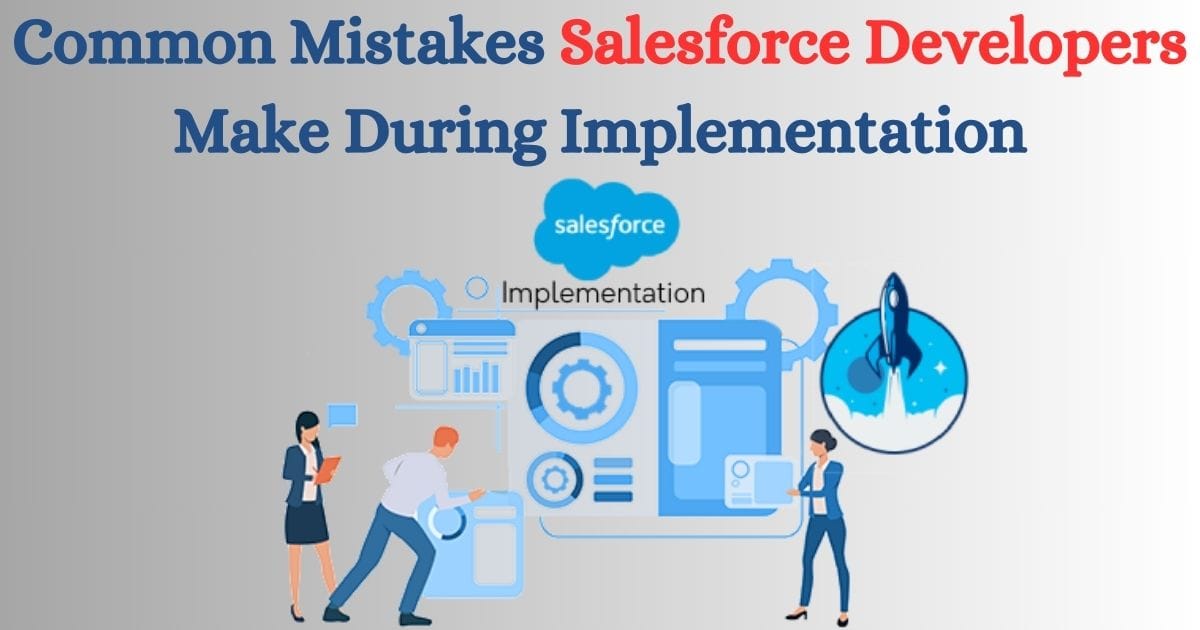
Have you ever tried to assemble the puzzle pieces to find what lies behind you? Well, it requires repetitive efforts, patience, and a keen eye for detail. Similarly, navigating challenges in the Salesforce implementation demands persistence to see the bigger picture.
However, not all possess these capabilities, leading to inevitable mistakes while installing and configuring Salesforce. In this guide, we’ll dive into those flaws and show you how to elevate your Salesforce implementation to another level. But before that, let’s learn a bit about Salesforce implementation.
What is Salesforce Implementation?
Salesforce implementation involves a full-fledged process of setting up and integrating its core product—CRM system. The system centralizes all key business activities in a unified place, providing information on customers to team members. Using the system, companies can personalize interactions with each customer based on the data received.
Moreover, they can leverage AI capabilities to effectively use data.
Salesforce has multiple advantages, such as better decision-making, improved scalability, boosted productivity, enhanced collaboration, streamlined customer management, etc. However, one can only achieve these benefits only after implementing Salesforce in the right way. For instance, a company should prevent committing certain mistakes that might hamper the implementation by following a dynamic procedure.
- Identify its unique needs
- Prepare a budget
- Connect and consult with the right expert
- Plan and create an organizational change management strategy
- Migrate their CRM data
- Roll out certain features gradually
- Prefer employee training
- Seek the right CRM maintenance and support
These steps are necessary for Salesforce to be set up. However, you might be trapped between the procedures if you make certain mistakes. Keep reading to learn more.
Common Mistakes to Avoid During Salesforce Implementation
Let’s steer clear of these mistakes to move on to the path of a seamless Salesforce implementation journey.
1. Neglecting the Discovery Phase
Businesses narrate their specific needs, goals, and potential roadblocks during the discovery phase. It is an initial step where the project team gathers requirements and identifies key processes. At this stage, you build the essential foundation for the entire implementation.
However, ignoring or rushing through it can lead to various negative consequences, impacting Salesforce implementation. For instance, it may result in a system that does not address your business challenges. Moreover, it may require costly changes to resolve issues that may have been avoidable through careful planning.
2. Building Too Complex System
Adding custom fields, automation rules, and workflows may seem to be appealing. However, it can overwhelm users and affect its long-term effectiveness. Moreover, overcomplicating design and features can cause other issues for the organization. For instance, if the user interface is cluttered, employees may resist using it.
Ultimately, it leads to higher system abandonment rates and increased training costs. To prevent overwhelming the team with system malfunctions, it is essential to get support from the Salesforce development company. Leveraging their expertise, they can create custom pages, reports, and dashboards that load faster, positively impacting the user experience.
3. Not Outlining Business Needs
Documenting business requirements, the company’s needs, and Salesforce’s offerings is important. However, if these essentials are not lined up, tracking needs and quantifying achievement may be difficult. Without clear documentation, Salesforce may struggle to fully support the company’s objectives.
You may also end up developing such features that don’t truly resolve business problems. That’s why mapping business requirements is important to track progress and measure success throughout the implementation. For instance, if you need to enhance sales pipeline visibility, ensure to define the outcomes like faster lead conversion.
4. Improper Training & Instruction
Without enough training, users may misuse or underuse the technology solution. And guess what? A complex Salesforce setup requires significant training resources for employees to use the system effectively. However, the steeper the learning curve is, the longer it will take for employees to become proficient in the system.
That’s why it is vital to plan and conduct effective training programs. By getting training support from a Salesforce implementation consultant, you can increase user adoption. For instance, you can equip your users with the right knowledge required for Salesforce implementation. Thus, ensuring that they can conduct each task with greater accountability in areas such as reporting and tracking.
5. Not Aligning Marketing and Sales
Investing in Salesforce is futile if your marketing and sales team operate in silos. You may face several complexities, missed opportunities, and decreased productivity when these teams function independently. Over time, this lack of alignment can lead to a fragmented CRM set up, with each team working on different systems.
This not only restricts the flow of information between departments but also limits the decision-making capabilities. Without a unified view of data and customer interactions, every team struggles to optimize their efforts. This leads to nothing but inefficiencies, missed chances, and the absence of a cohesive working environment.
6. Ignoring Integration Requirements
Salesforce is integrated with other technologies like email marketing platforms to ensure data consistency across platforms. However, when not integrated properly, users may find it problematic to access the right information at the right time. Moreover, they may fail while playing their crucial roles and responsibilities.
But, with the Salesforce AI service provider, you can integrate as many systems as you want, ensuring data accuracy and transfer throughout the organization. Besides, you can effectively use the system to perform various tasks, helping you grow your business without significant slowdowns.
7. Not Identifying Poor Quality of Data
Poor data quality leads to inaccurate KPIs, reporting and analytics. It’s often due to data silos and faulty insights that businesses struggle to get a comprehensive view of their operations. This ultimately leads to improper decision-making, inconsistent processes, and diminished collaboration. Moreover, you lack a baseline for measuring success and tracking progress.
Well, that’s where support from the best Salesforce development company is required. You can enhance your overall business operations with the right people working behind the scenes to refine your metrics. Salesforce partners help you ensure the system cleans, standardizes, and deduplicates the data before moving it. Additionally, it maintains the data hygiene required for efficient reporting and decision-making capability.
8. Failure to Get Implementation Support
Continuous assistance and support are essential for the system to run effectively over time. Without regular assistance and upkeep, new issues could appear, return on investment might decline, and user adoption could drop. Moreover, users may face difficulties updating the system to the currently available version. The situation worsens when the users are not trained properly to identify the upgrade need.
To quickly resolve this issue, you must hand over the system elevation task to your consultant partner. Leveraging their dynamic expertise and experience, specialists can ensure successful post-implementation assistance. They can ensure that the system remains up-to-date, optimized, and fully aligned with evolving business needs. This ongoing support also maximizes the long-term value of your Salesforce investment, consistently ensuring performance.
9. Choosing an Inappropriate Salesforce Implementation Partner
This might be another mistake, preventing you from making the most out of Salesforce implementation. So, when looking for a Salesforce implementation company, ensure they have the required knowledge and expertise. Skip joining hands with those who don’t understand your business’s unique requirements and workflows.
This may result in redundancies, inefficiencies and an improper balance between Salesforce’s capabilities and your business goals. To prevent this factor from happening, start searching for a partner who has essential certifications and industry specialization. This ensures a smooth transition during the entire implementation procedure. Additionally, carefully assess their case studies and client testimonials to ensure a sustainable digital transformation.
10. Not Testing Thoroughly
After deploying codes, testing and debugging are required, which most developers fail to do. Not doing so can result in overlooking such issues that might impact Salesforce’s performance down the road. Additionally, failing to properly test can result in system inefficiencies, unforeseen bugs, or even downtime. As a result, the team struggles to maintain their daily tasks and faces challenges while optimizing the system.
While getting assistance from the Salesforce implementation partner, you can easily skip the hassle of testing codes. These experts conduct everything from setting up to configuration and testing. They ensure that the platform runs effectively without bugs, issues, and errors, letting businesses accelerate their business operations at 5x speed.
To Conclude!
There is no denying that Salesforce implementation is a complex process. This complexity is often the root cause of the challenges businesses face globally during the setup. However, partnering with an experienced Salesforce consulting company is the key to avoiding these pitfalls.
A skilled consultant streamlines the entire implementation process. Moreover, with their expertise, businesses proactively address potential issues. This ensures a seamless and smooth workflow from the day Salesforce is used. Consider meeting with the right and experienced Salesforce implementation partner if you want to minimize disruptions, maximize Salesforce investment, and leverage the platform’s full potential. With their support, you can enrich your business potential like the way you’ve always dreamed of.








